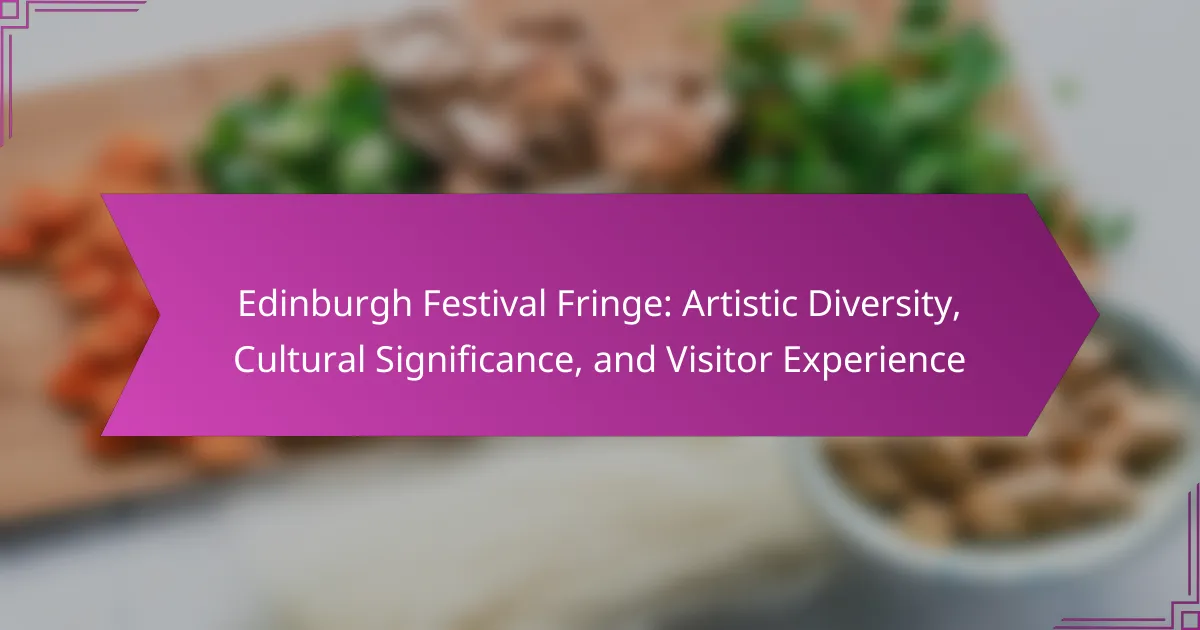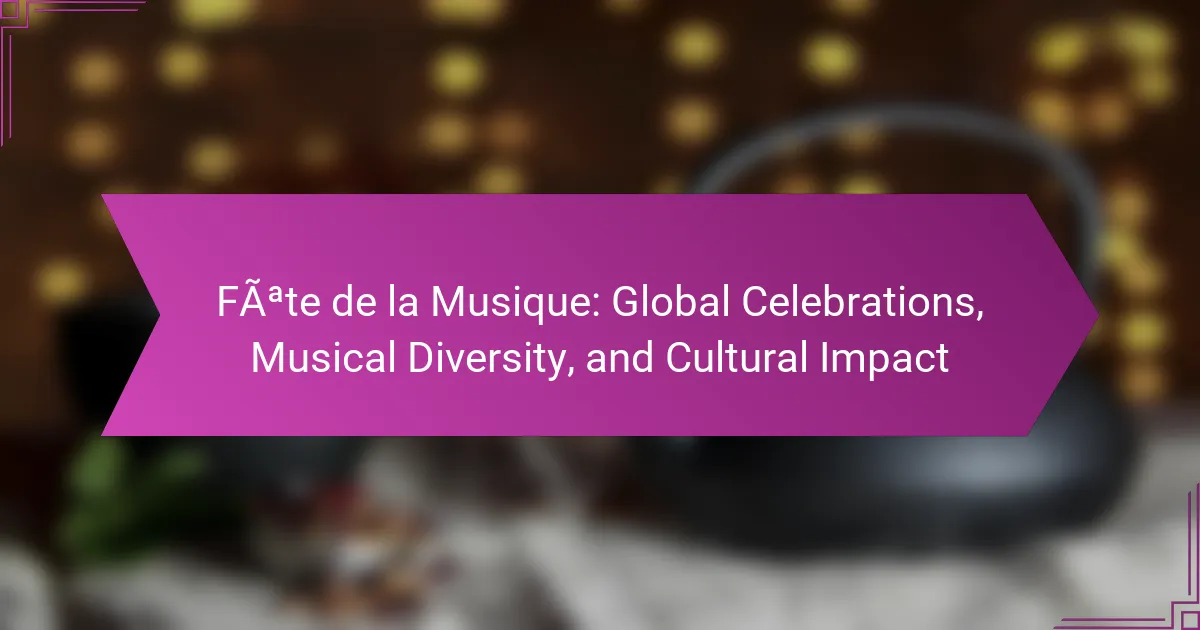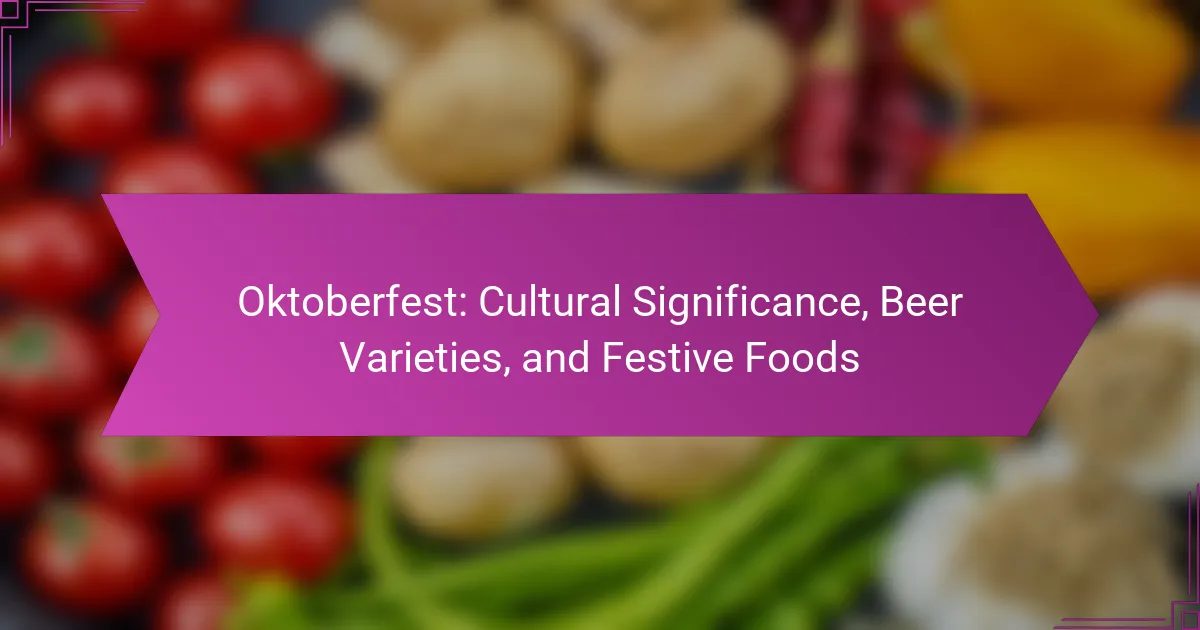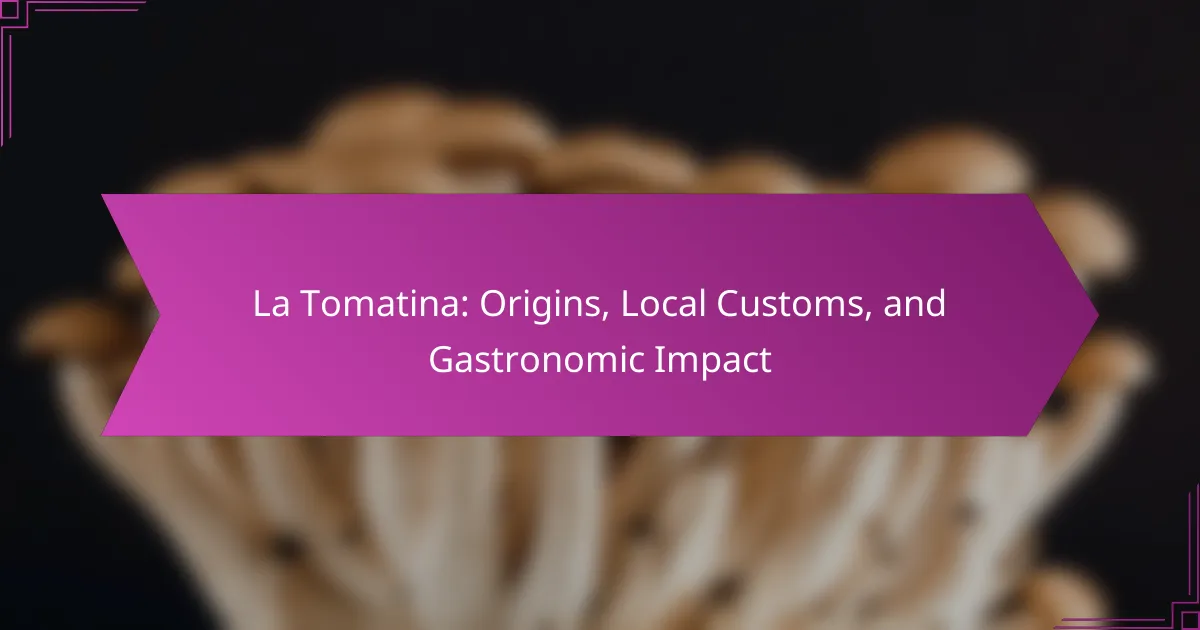Experience the vibrant San Fermín Festival in Pamplona, Spain, where thrilling traditions like the running of the bulls, rich culinary highlights featuring pintxos, and deep cultural heritage come together. Discover the festival’s key events, including the opening ceremony and traditional music, that create a lively atmosphere. Explore the local gastronomy that enhances this communal celebration, reflecting the region’s identity and history.
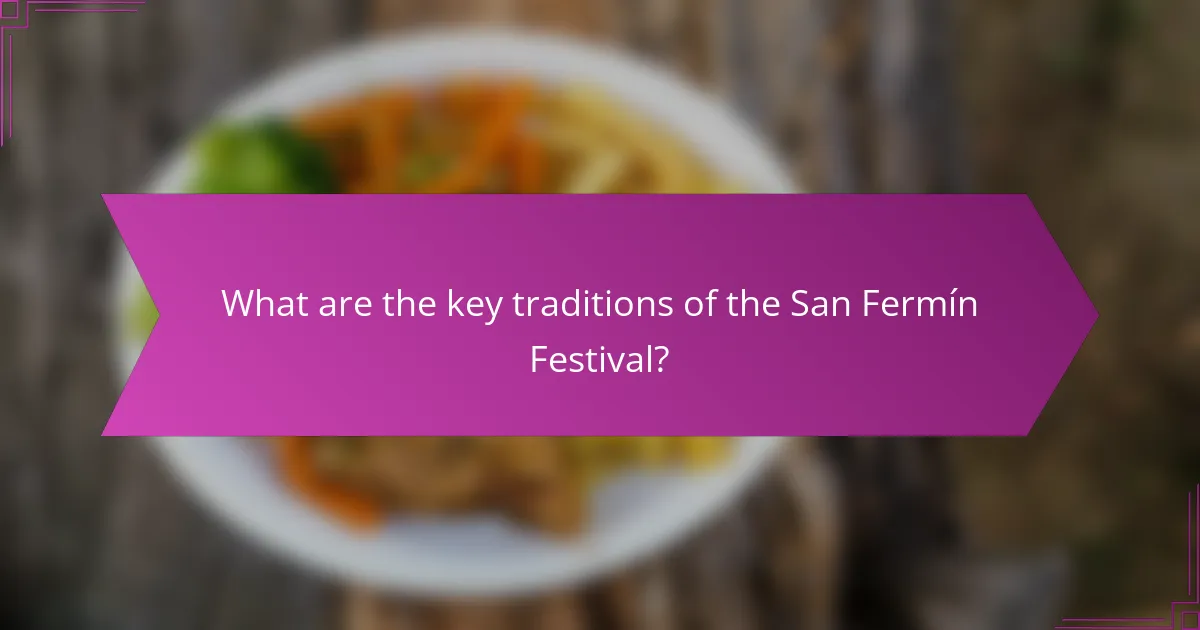
What are the key traditions of the San Fermín Festival?
The key traditions of the San Fermín Festival include the running of the bulls, the opening ceremony, and traditional music and dance. The festival, held annually in Pamplona, Spain, showcases vibrant cultural expressions and communal celebrations.
The running of the bulls is a unique event where participants run in front of a group of bulls. This thrilling spectacle attracts thousands of spectators each year. The opening ceremony features a traditional chant, “Chupinazo,” marking the festival’s official start.
Culinary highlights include local dishes like “pintxos,” which are small snacks typically served with drinks. Traditional music, such as “txistu” and “danzón,” fills the streets, enhancing the festive atmosphere. Each of these traditions contributes to the festival’s rich cultural heritage.
How do the daily events unfold during the festival?
During the San Fermín Festival, daily events are vibrant and structured, featuring a blend of tradition and celebration. Each day begins with the famous “chupinazo,” a rocket launch that marks the festival’s official start. Following this, locals and visitors participate in the morning encierro, where they run alongside bulls through the streets.
Afternoons are filled with cultural activities, including traditional music, dance, and parades showcasing regional costumes. Culinary highlights emerge as food stalls offer local specialties like pintxos and churros. Evenings culminate in lively gatherings, with fireworks lighting up the sky, creating a festive atmosphere that embodies the spirit of the festival.
This unique blend of events makes each day at San Fermín a memorable experience, celebrating the rich cultural heritage of Pamplona.
What role does the Running of the Bulls play in the celebrations?
The Running of the Bulls is a central event in the San Fermín Festival, symbolizing tradition and excitement. This spectacle attracts thousands, showcasing bravery and cultural heritage. Participants run ahead of the bulls through the streets of Pamplona, creating a thrilling atmosphere. It embodies the festival’s spirit, blending adrenaline with communal celebration. The event also highlights unique local customs, reinforcing the festival’s significance in Spanish culture.
Which traditional costumes are worn by participants?
Participants in the San Fermín Festival wear traditional costumes known as “chulapos” and “chulapas.” These outfits typically feature a white shirt, red scarf, and black trousers for men, while women wear a long skirt and blouse. The costumes reflect the festival’s cultural heritage and regional identity. Participants often accessorize with colorful sashes and hats, enhancing the festive atmosphere.
How is music integrated into the festival experience?
Music is integral to the San Fermín Festival, enhancing the celebratory atmosphere. Traditional songs, bands, and performances create a vibrant experience, connecting attendees to cultural heritage. The presence of live music fosters community spirit and participation, making it a unique aspect of the festival. Additionally, specific musical genres, such as folk and regional styles, highlight the festival’s roots and traditions.
What are the historical origins of these traditions?
The San Fermín Festival has origins tracing back to the 13th century. Initially, it celebrated the co-patron saint of Navarre, San Fermín, with religious processions. Over time, the festival evolved, incorporating bull running and various cultural events. This transformation reflects the blend of local customs and historical influences, particularly from Spanish traditions. The unique attribute of this festival is its vibrant atmosphere, characterized by music, dance, and culinary delights, showcasing the rich cultural heritage of Pamplona.
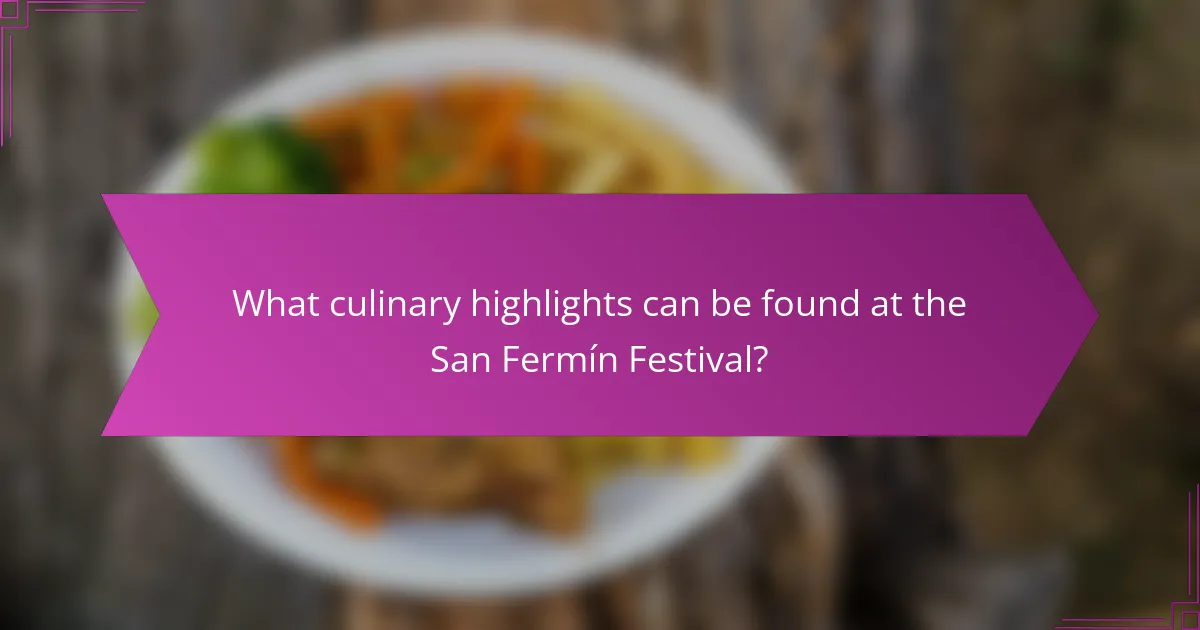
What culinary highlights can be found at the San Fermín Festival?
The San Fermín Festival features culinary highlights such as traditional dishes, local wines, and unique snacks. Popular foods include pintxos, a variety of tapas, and the famous churros with chocolate. Additionally, the festival showcases regional specialties like lamb stew and local cheeses. The vibrant atmosphere enhances the experience, making food a central part of the celebration.
Which local dishes are must-tries during the festival?
During the San Fermín Festival, must-try local dishes include pintxos, churros, and the traditional dish of paella. Pintxos are small snacks served on bread, often topped with various ingredients. Churros, a popular sweet treat, are deep-fried dough pastries typically enjoyed with hot chocolate. Paella, a rice dish originating from Valencia, features saffron and a mix of seafood or meats. These dishes showcase the rich culinary heritage of the region and enhance the festival experience.
How do food stalls contribute to the festival atmosphere?
Food stalls significantly enhance the San Fermín Festival atmosphere by offering diverse culinary experiences. They create a vibrant social space where festival-goers gather to enjoy traditional dishes like pintxos and churros. The stalls also reflect local culture, showcasing regional ingredients and cooking methods. This culinary diversity fosters community interaction and contributes to the festival’s festive spirit.
What beverages are traditionally enjoyed during the festivities?
During the San Fermín Festival, traditional beverages include red wine, particularly local varieties like Navarra wine, and sangria. Additionally, txakoli, a slightly sparkling white wine from the Basque Country, is popular. These drinks enhance the festive atmosphere and complement the culinary offerings. The festival’s unique attribute lies in its emphasis on regional flavors, showcasing local beverages that reflect the cultural heritage of the area.
How do culinary experiences vary by region during the festival?
Culinary experiences during the San Fermín Festival vary greatly by region, showcasing local ingredients and traditional dishes. In Pamplona, the festival features pintxos, small snacks often served on bread, highlighting the Basque culinary tradition. Meanwhile, other regions may emphasize unique specialties like roasted lamb or seafood, reflecting their agricultural and maritime heritage. Each area’s offerings contribute to the festival’s rich tapestry of flavors and cultural significance.
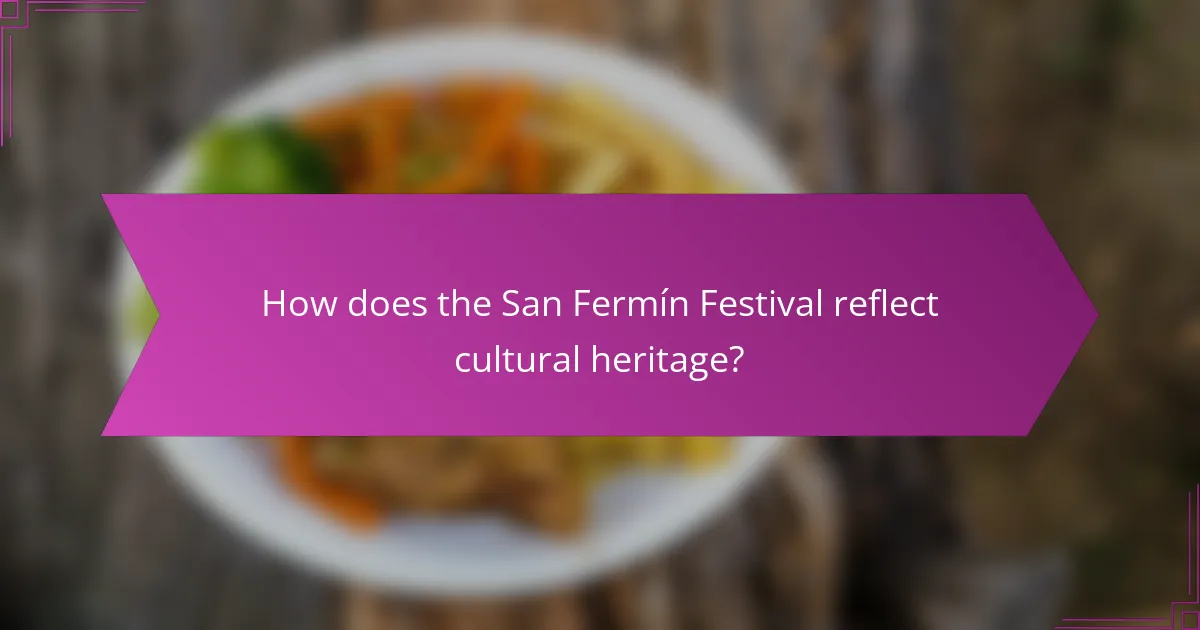
How does the San Fermín Festival reflect cultural heritage?
The San Fermín Festival reflects cultural heritage through its vibrant traditions and communal participation. Rooted in the 16th century, the festival celebrates the patron saint of Pamplona, San Fermín. Key traditions include the famous running of the bulls, religious processions, and traditional music that highlight regional customs. Culinary highlights, such as local dishes like pintxos and churros, showcase the area’s gastronomy, further enriching the cultural experience. The festival fosters a sense of identity and community, attracting visitors and locals alike to partake in its rich history and lively atmosphere.
What significance do the festival’s rituals hold for local communities?
The rituals of the San Fermín Festival hold deep significance for local communities as they foster cultural identity and social cohesion. These traditions, including the iconic running of the bulls, create a sense of belonging among participants. The festival’s rituals also serve as a means of preserving historical customs and passing them down through generations. Engaging in these practices strengthens community bonds and enhances local pride, making the festival a vital aspect of cultural heritage in Pamplona.
How does the festival promote regional identity and pride?
The San Fermín Festival fosters regional identity and pride through its vibrant traditions and community involvement. Local customs, such as the iconic running of the bulls, showcase Basque culture and history, creating a sense of belonging among participants. Culinary highlights, including traditional dishes like pintxos, reinforce local gastronomy and celebrate regional ingredients. The festival’s communal atmosphere encourages unity and pride, as residents and visitors engage in shared experiences that honor the rich cultural heritage of Pamplona and its surroundings.
What role do local organizations play in preserving festival traditions?
Local organizations play a crucial role in preserving the San Fermín Festival traditions by actively engaging the community. They organize events, educate participants, and maintain cultural practices. These organizations ensure that traditional activities, such as the famous running of the bulls and local culinary highlights, are celebrated authentically. Their efforts help sustain the festival’s unique heritage, fostering a sense of identity among locals and visitors alike. Through workshops and collaborations, they pass down knowledge and skills related to the festival’s customs, ensuring continuity for future generations.
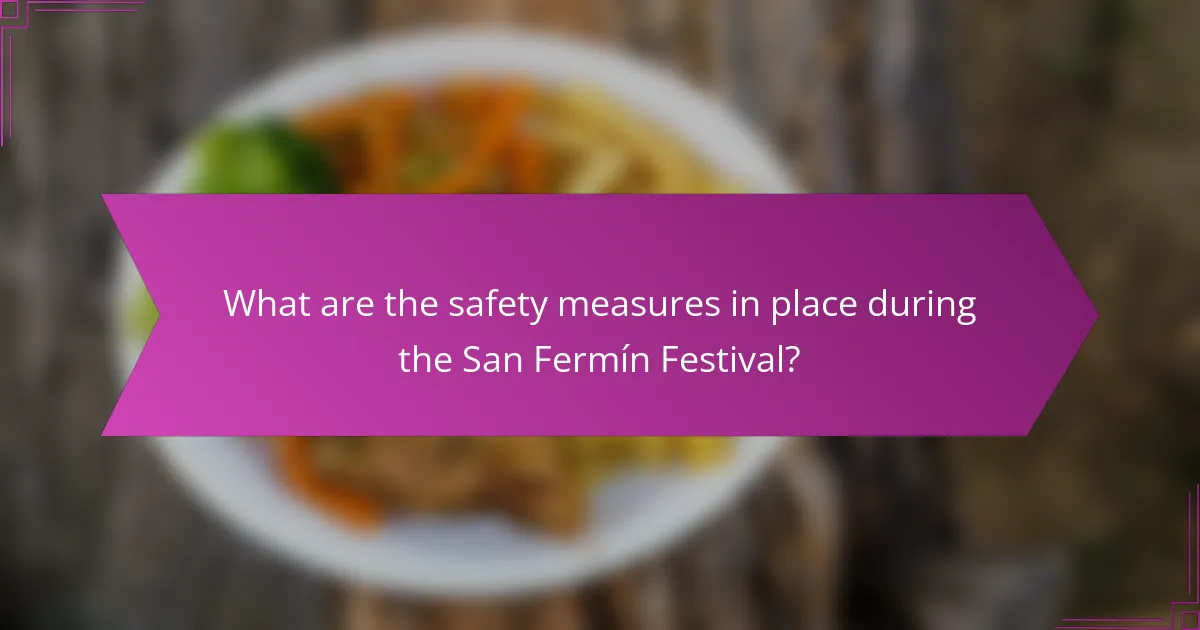
What are the safety measures in place during the San Fermín Festival?
The San Fermín Festival implements various safety measures to protect participants and spectators. Key measures include crowd control, designated emergency response teams, and strict regulations regarding alcohol consumption.
Additionally, barriers are installed along the running route to prevent accidents. Surveillance cameras monitor the event, enhancing security. First aid stations are strategically placed for immediate medical assistance.
These measures aim to ensure a safe environment while preserving the festival’s vibrant atmosphere.
How does crowd management impact the festival experience?
Crowd management significantly enhances the San Fermín Festival experience by ensuring safety and facilitating movement. Effective crowd control minimizes congestion, allowing attendees to enjoy events like the Running of the Bulls and traditional music performances without overwhelming stress.
Proper crowd management strategies, such as designated pathways and crowd flow monitoring, contribute to a more enjoyable atmosphere. For instance, managing entry points prevents bottlenecks, enhancing overall accessibility.
Additionally, trained personnel can respond promptly to emergencies, ensuring participant safety. This proactive approach fosters a sense of security, allowing festival-goers to immerse themselves in the cultural heritage and culinary highlights of the event.
In summary, effective crowd management is crucial for a positive San Fermín Festival experience, balancing safety with the vibrant atmosphere that defines this cultural celebration.
What precautions are taken for the Running of the Bulls?
The Running of the Bulls at the San Fermín Festival involves several precautions to ensure safety. Participants must wear appropriate clothing, including a white shirt and red scarf, to maintain tradition and visibility. Barriers are erected along the route to protect spectators. Medical teams are on standby to address injuries promptly. Additionally, runners are advised to avoid intoxication and to stay aware of their surroundings to prevent accidents. These measures aim to minimize risks associated with the event while preserving its cultural significance.
How do local authorities ensure participant safety?
Local authorities ensure participant safety at the San Fermín Festival through strict regulations, emergency services, and crowd management. They implement measures such as designated safety zones, medical assistance stations, and trained personnel to manage events. Additionally, public awareness campaigns educate attendees on safety protocols. These efforts help mitigate risks associated with large gatherings and traditional activities.
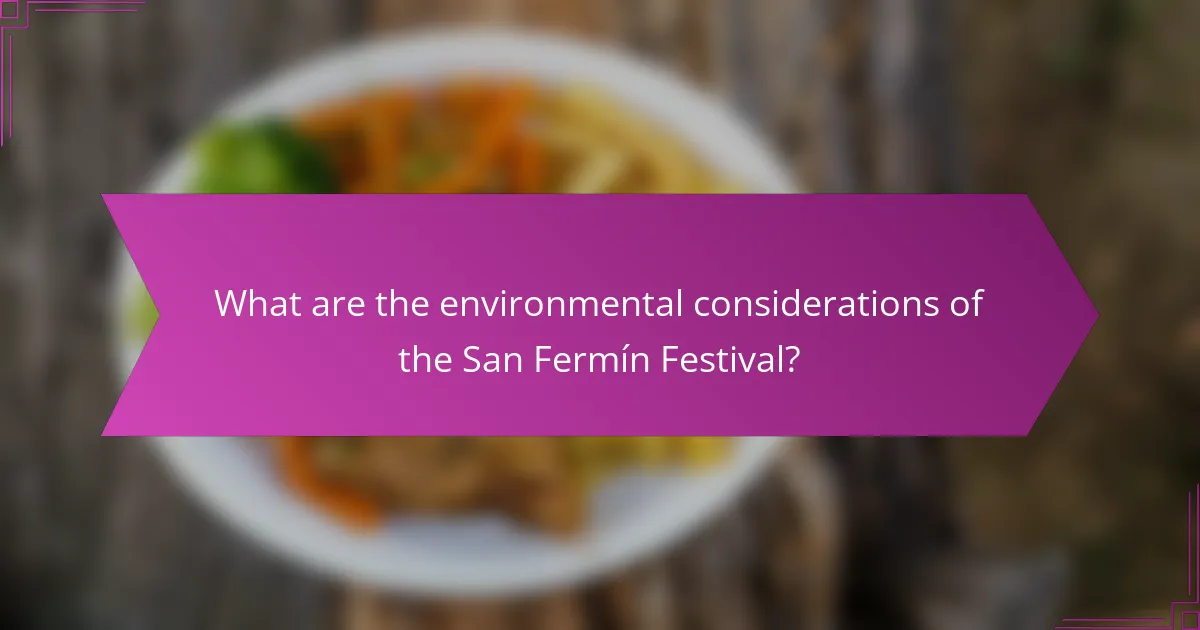
What are the environmental considerations of the San Fermín Festival?
The San Fermín Festival raises significant environmental considerations, particularly concerning waste management and resource consumption. The influx of visitors leads to increased litter, requiring effective waste disposal strategies. Noise pollution from festivities can disrupt local wildlife. Additionally, transportation impacts the carbon footprint, necessitating sustainable travel options. The festival’s cultural significance must balance with ecological responsibility to preserve the environment for future generations.
How is waste managed during the celebrations?
Waste management during the San Fermín Festival involves organized collection and recycling initiatives. The festival employs a dedicated team to ensure cleanliness and minimize environmental impact.
Recycling bins are strategically placed throughout the festival area to encourage proper waste disposal. The local government collaborates with volunteers to educate attendees on waste management practices.
As a result, the festival aims to reduce waste generation by 30% compared to previous years. Innovative solutions, such as biodegradable materials for food vendors, contribute to this goal.
Overall, effective waste management enhances the festival’s sustainability and preserves the cultural heritage of the San Fermín celebration.
What initiatives are in place to promote sustainability?
The San Fermín Festival promotes sustainability through various initiatives. These include waste reduction programs, local sourcing of food, and eco-friendly transportation options. The festival encourages the use of reusable materials and implements recycling stations throughout the event. Additionally, collaborations with local environmental organizations help raise awareness of sustainability practices among attendees.
How do local businesses contribute to eco-friendly practices?
Local businesses significantly contribute to eco-friendly practices by promoting sustainability and reducing environmental impact. They often adopt green initiatives such as using locally sourced materials, minimizing waste, and supporting eco-friendly suppliers.
For example, many local restaurants participate in farm-to-table programs, ensuring fresh ingredients while reducing transportation emissions. Additionally, local shops may implement recycling programs and use biodegradable packaging.
These practices not only benefit the environment but also foster community engagement. By prioritizing sustainability, local businesses enhance their brand image and attract environmentally conscious consumers.
Overall, the collective efforts of local businesses create a positive ripple effect, encouraging eco-friendly behavior within the community.

What are the best practices for attending the San Fermín Festival?
To fully enjoy the San Fermín Festival, follow these best practices: arrive early to secure accommodations, participate in traditional events like the running of the bulls, and savor local cuisine such as pintxos. Dress appropriately for the weather and wear comfortable shoes for walking. Engage with locals to enhance your experience and respect cultural traditions throughout the festivities.
How can visitors prepare for the festival experience?
Visitors can prepare for the San Fermín Festival by understanding its traditions, planning their itinerary, and packing appropriately. Familiarize yourself with the festival’s key events, such as the Running of the Bulls and daily parades. Arrive early to secure accommodations and enjoy local culinary highlights, including pintxos and traditional wines. Dress comfortably in white clothing with a red scarf to fully embrace the festival spirit. Lastly, be mindful of safety guidelines to ensure an enjoyable experience.
What common mistakes should festival-goers avoid?
Festival-goers should avoid common mistakes to fully enjoy the San Fermín Festival. First, neglecting to plan accommodations can lead to last-minute stress. Second, failing to stay hydrated and nourished can result in fatigue during the festivities. Third, overlooking local customs may lead to cultural misunderstandings. Lastly, not wearing appropriate attire can hinder comfort and safety during the running of the bulls.
Which tips can enhance the enjoyment of the festival?
To enhance the enjoyment of the San Fermín Festival, immerse yourself in its vibrant traditions, culinary delights, and cultural events. Engage with the local community, participate in traditional activities, and savor regional dishes.
1. Attend the opening ceremony to experience the excitement and energy.
2. Sample local delicacies like pintxos and churros to appreciate the culinary heritage.
3. Join in traditional dances and music to connect with the cultural atmosphere.
4. Explore the festival’s historical sites for a deeper understanding of its significance.
